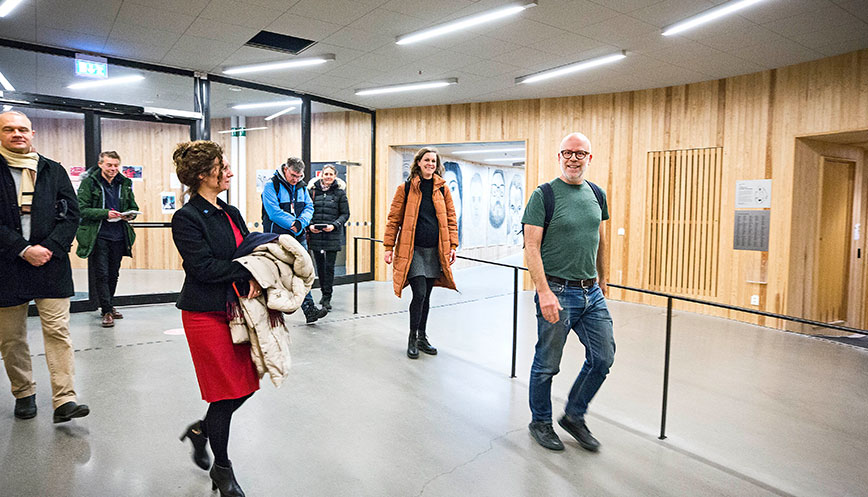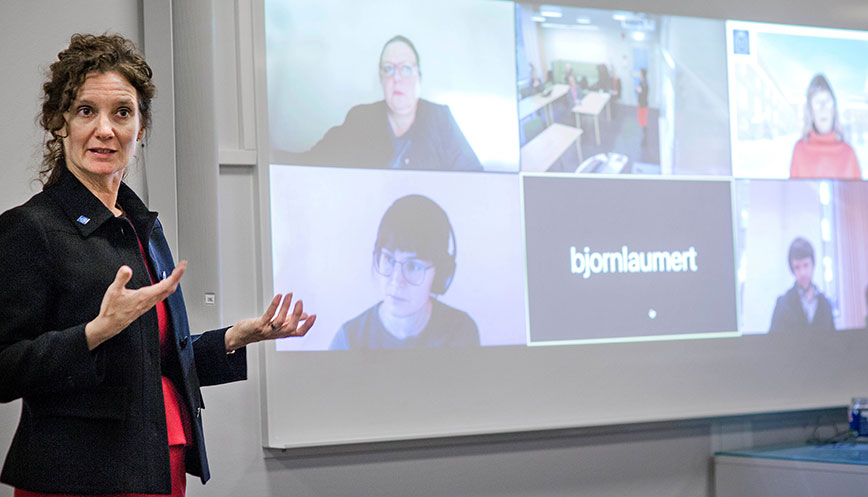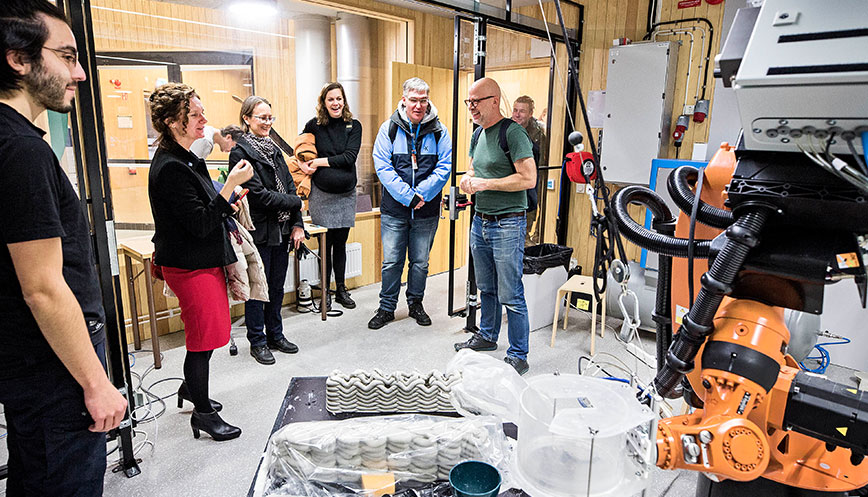3D-printed concrete and reuse on show during ABE visit

The Energy Platform’s last school visit for the 2021 autumn term was to the School of Architecture and the Built Environment (ABE). During the visit, Platform representatives attended presentations on new research projects and made well-received visits to concrete labs and drawing offices where students were working flat out.
Every autumn, the Energy Platform makes a series of school visits to learn about ongoing activities and new opportunities for collaborations. The visits also provide a snapshot of energy research and energy researchers at KTH. This makes it possible to link projects and people in new initiatives with the help of the Platform’s funding.
The Energy Platform has made two previous visits to the ABE school, one physical , and one digital .

Broad-based energy research
The visit began with a discussion that highlighted how researchers and projects with an energy focus are dotted throughout ABE. Research is conducted in many different areas and often with a wide variety of approaches. Projects range from transport systems to building technologies and from system level to end-users. Research also includes the electrification of society in everything from practical applications to issues such as equality and democracy. Many researchers also work in other disciplines, i.e. they are active in areas in addition to energy.
Smart grids impact households
Cecilia Katzeff, researcher in Human Computer Interaction at SEED, then delivered a presentation that provided insights into the “Home Energy Stories” project, which looks at the transition to a sustainable society with a focus on how households are affected by new smart grids. Smart grids are set to involve households as active parts of the energy system to a much greater extent than ever before.
Flexibility is one of the issues this research looks at: how can smart grids be adapted to household needs? How will the supply and consumption of electricity be communicated to households, and how does automated control of technology such as heat pumps affect households? Is it possible to involve households more in these changes, especially as in the future they will not only be consumers, but also producers of electricity.
Discussions then moved to urban development and the urban environment. Oleksii Pasichnyi and Xavier Faure - researchers at the ABE School - spoke about the Viable Cities innovation programme.

Among the issues researchers tackle is how urban energy data can improve strategic city planning. Data from energy consumption and heating, for example, are integrated into interactive models.
Researchers are developing new digital tools to help city developers and property owners improve decision making in development and renovation. In most cases, data for these tools comes from property energy declarations. Some tools are already available as open source.
Kåre Gustafsson then gave a presentation on work being done in Bio Energy Carbon Capture and Storage (BECCS). Gustafsson explained different forms of technology for capturing carbon dioxide, especially in urban district heating systems; how carbon dioxide collection affects the surrounding environment; and how it can be done efficiently, including through methods for producing biochar. He gave examples of existing pilot schemes in Stockholm with technology that is planned to be tested in scaled-up plants in future. This is a collaboration with Stockholm Exergi.
Local impact of wind power
Hans Westlund rounded off the presentations with a deep-dive into planning perspectives on wind power development. Westerlund has investigated the effects of wind power expansion on the number and types of jobs it creates. Among the conclusions he presented was that greater use of wind power creates more long-term jobs than previously thought. Jobs arise regionally during the entire life of a wind farm, not only during the construction period.
Westerlund also addressed the perceived disadvantages of wind turbines such as light and sound disturbances and reduced access to natural environments. Something that surprised him was the absence of studies that showed the impact on property prices around wind farms. Negative impacts on property values have been established in some European studies, although this link has not been shown to be as strong in the US.
When Westerlund conducted his own study, he was able to show a negative effect on property values within two kilometers of wind farms. The effect diminished the further away from the wind farm properties were located. This research will be followed up in the coming years in case studies in various places in Sweden.
He also stressed the need for new compensation models for people who live close to new wind farms. Existing models in Sweden provide lower remuneration than in other Nordic countries.
3D-printed concrete
After the seminar, the group visited the Department of Architecture under the leadership of Erik Stenberg. Labs for the manufacture of concrete of the future and student projects on the recycling of concrete slabs were shown.
Researchers Helena Westerlind and José Hernández showed their lab where they research 3D-printed concrete. Their work looks at various methods to adapt new structures with concrete to reduce the consumption of materials and environmental impact.

Customized industrial robots as well as custom-made nozzles and 3D printers are used in these labs. The goal is to create exact structures for specific applications. Researchers are in part inspired by traditional crafts such as knitting and crochet. The research is funded by the Swedish Construction Industry Development Fund and Formas, among others.
Student recycling concrete project
The group then took the lift to the drawing offices where approximately 500 students work. This is where students draw and construct models and apply their knowledge of theory, history and technology.

During the autumn of 2021, Helsingborgshem and a group of students worked on recycling concrete slabs in the Drottninghög area, northeast Helsingborg. The area is being heavily redeveloped with some buildings being demolished and elements from them may be reused in new buildings. Currently, concrete is mainly reused as backfill, but here there is a potential to reuse concrete in new buildings to reduce their environmental impact.
Two students demonstrated projects where recycled slabs are used to reduce the proportion of new concrete in a building, as well as build new floors and wings for existing buildings. Among the difficulties students face is adapting the scale and appearance of changes to the dimensions of recycled slabs.
A pavilion of recycled concrete is planned for the H22 trade fair in Helsingborg, as well as a digital pilot.
Findings from these projects will be shared with other European countries within the framework of the EU-led Recreate research project .
Text: Magnus Trogen Pahlén

